Henry Cloud's Blog, page 2
May 11, 2020
How to Discern Hurt from Harm in a Relationship
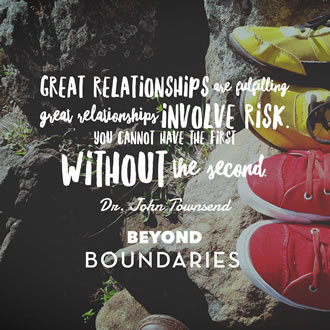 Great relationships are fulfilling. Great relationships involve risk. You can’t have the first without the second.
Great relationships are fulfilling. Great relationships involve risk. You can’t have the first without the second.
Great relationships require that you be open to taking risks—risks of being misunderstood, of alienation, of someone being hurt by you as well. It doesn’t mean relationships aren’t worth the risks, for the good ones are. It is simply the price of the course. No pain, no gain.
The challenge is that people who have been burnt in a relationship often have trouble with risk. They get out of balance. Sometimes they insist on no risk and try to control the course of the relationship. This can actually be boring and unfulfilling. And sometimes they allow behavior that is unacceptable in the name of taking risks. In other words, they don’t quite know the difference between risks that are worth taking and risks that are not worth taking. In order to move beyond boundaries and prepare yourself for openness and vulnerability, you have to clarify which risks are—and are not—worth taking.
For example, Nick was a man who came from a harsh and controlling family. He had few choices as a boy and had adopted a compliant personality style to survive his childhood. He just toed the line to make it from day to day and never expressed his real thoughts and feelings. His compliance pattern worked for him, and he learned to channel his energies into being a business success. He worked great in authoritarian structures, where the boss was strict and rigid. But he felt dead inside, and he knew it was a problem.
As I (Dr. Townsend) worked with Nick, he became aware of how much legitimate personal power and control he had never had. As often happens, when he got in touch with those feelings, he went through a season of becoming controlling himself, sort of turning the tables. Actually, it was a way for him to separate himself enough from the controlling dad in his mind, to become more comfortable with his own power. But during this season, he was hard to live with. When his wife disagreed with him about a financial decision he made, for example, this normally easygoing guy said, “If you loved me, you would support and trust me.” In other words, he interpreted her freedom as a lack of love and as something that was not good for him.
But here is the reality: the problem is never the freedom. The problem is always the character of two people: yours and the person you love. Don’t make freedom the bad guy; instead, you must celebrate and protect it, because without it there is no love. But you get hurt either because the person was unloving, there was a miscommunication, or you allowed something you shouldn’t have, or because you wanted something that wasn’t possible. So that leads us to the question of risk. If risk is inevitable and even a good thing, you need to understand the difference between risks that are acceptable and those that are not.
How do you discern the difference between a hurtful result and a harmful result when you take a risk? Here’s the distinction: while hurt is the experience of something painful, it may not be damaging. But harm is different. Harm creates significant problems in the three primary areas of life:
1. Withdrawal from other relationships
If your experience in a relationship affects how you relate to other people in a significantly negative way, this is a sign of harm. For example, if you find yourself unable to reach out and let others in, isolate yourself from people, or withdraw from support, that is harm. The difficult relationship caused damage that impacts your other relationships, and you need time and attention to heal.
2. Personal decline
Your personal life encompasses everything that happens inside your skin: your behaviors, how you feel about yourself, your emotional well-being, and your habits. If the relational conflict results in any kind of sustained personal decline — for example, depression, significant weight change, or incapacitating self-doubt—that is harm.
3. Diminished performance
Performance has to do with the doing aspects of life, the tasks and activities. Your job, career, financial life, home organization, and time management are parts of the performance piece. Harm happens when you can no longer function at the same levels you did or find that you can start projects and tasks but can’t finish them. Often, a person will experience problems in energy, focus, creativity, or enjoyment of work.
Are you starting to see the difference between hurt and harm more clearly? Does it give you a better idea of the kinds of risks that routinely come with connection and the kinds of risks that should never be taken? Here are some additional examples to help make the difference crystal clear:
It is acceptable to have an argument, but not to be yelled at and treated with contempt.
It is acceptable to pick the wrong person, but not to let that person take over your life, thoughts, and values.
It is acceptable to open up to a person and feel bad if they become critical of you, but not to allow it to happen repeatedly.
It is acceptable to give up controlling the outcome of the relationship and where it will end up, but not to let the other person’s choices be the only choices.
When problems happen in a relationship, keep pushing through hurt, as long as you are committed to the relationship. But pay attention to when things cross the line into harm.
________
Beyond Boundaries by Dr. John Townsend is the must-read guide designed to help you reinstate appropriate closeness with someone who broke your trust, discern when true change has occurred, and restore former relationships to a healthy dynamic. Learn More
 Get The 10 Laws of Boundaries eBook when you subscribe to the Boundaries Weekly email newsletter. Learn More
Get The 10 Laws of Boundaries eBook when you subscribe to the Boundaries Weekly email newsletter. Learn More
The post How to Discern Hurt from Harm in a Relationship appeared first on Boundaries Books.
May 5, 2020
What to Do When Your Teen Pulls Away
 By Dr. John Townsend
By Dr. John Townsend
Some parents fear that if they set boundaries with teens, it will cause their son or daughter to detach themselves and withdraw their love from them. This fear can cause these parents to avoid boundaries at all costs, and to do their best to keep their kid connected.
When this happens, it teaches teens that they can get their way and avoid limits by cutting off the love supply. These adolescents often have difficulty experiencing healthy adult relationships, because they have learned to withdraw love, as a form of emotional blackmail, until the other person caves in. You don’t want this relational future for your teen.
If you are vulnerable to fear, you may have some sort of dependency on your teen’s goodwill and feelings toward you. You may be trying to get your teen to meet your need for love and connection. If so, you are in jeopardy of not doing right by your child.
To resolve your fear of withdrawal of love, connect with other adults who will support, affirm, and encourage you. Such adults can meet your relational needs. Use their good feelings to fill the vacuum so that when your teen withdraws because of some limits you have imposed, you can tolerate the withdrawal.
When your teen withdraws, take the initiative to go after him and try to reconnect. Teens sometimes don’t have the skills to pull themselves back into relationship, so they need their parents to help them. But while you are inviting your teen back into connection with you, keep your requirements and expectations intact. Your teen still needs them.
Remember that teens need a certain amount of time and space to pull away from parents — not totally away, but enough to form their own opinions, identity, and values. When you experience this withdrawal, realize it’s a normal part of your teen’s developmental passage. Don’t personalize it. Instead, help your teen know that it’s a good thing for him and that you’ll be there when he or she wants to reconnect.
________
Learn more ways to help your teen grow into a mature, responsible adult by reading Boundaries with Teens. Click here to learn more.
 Get The 10 Laws of Boundaries eBook when you subscribe to the Boundaries Weekly email newsletter. Learn More
Get The 10 Laws of Boundaries eBook when you subscribe to the Boundaries Weekly email newsletter. Learn More
The post What to Do When Your Teen Pulls Away appeared first on Boundaries Books.
April 28, 2020
How to Confront Your Mother in a Loving Way
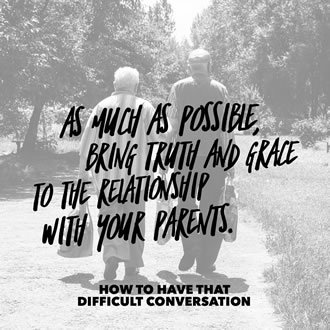 Recently a woman asked me (Dr. Townsend), “How can I confront my mom to open up and be more involved in my life?”
Recently a woman asked me (Dr. Townsend), “How can I confront my mom to open up and be more involved in my life?”
“Well, have you asked her?” I responded.
“Sure! I told her that it would be nice if she asked me how my life was going, but she still didn’t do anything.”
“Well, let’s not say that you asked her anything. Call it a suggestion, or maybe a mention of a good idea. But, there was no direct request. If she didn’t respond, you probably need to ratchet it up a bit and say something like, ‘Mom, you rarely ask me about myself; I seem to be the only one asking you about your life. I’d like you to ask me how my work, kids, and activities are doing.’”
It is easy to be indirect with parents, given all the emotional complexities involved. Sometimes a person will even think, “She is my mom. She should know I need this without my being blunt about it.” But if what you have said is not getting through, you have to be direct and clear, though not mean.
Confront your mother from a stance of being an adult, rather than from a position as being her child. The basic difference is to make your discussion more about the relationship and less about your needs. Here are some examples of both versions:
Child: “I want you to be there for me.”
Adult: “I want to be able to communicate openly with you.”
Child: “I need for you to respect me so that I can feel respected.”
Adult: “I want you to treat me with respect so that it doesn’t get in the way of our relationship.”
Child: “I want you to be able to hear me when I say no, because I feel bad about myself when you don’t.”
Adult: “I want you to be able to accept our different opinions so that we can have healthy conversations.”
Child: I want you to stop drinking so that I can have the mom I never had.”
Adult: “I want you to stop drinking, because none of us can connect with you, and it hurts us and you, too.”
Decide Whether a Conversation Is Worth It
You may discover over time that confronting your mother is just not worth the cost. Barring life-threatening or very serious issues, you may need to let some things go and accept things the way they are.
You don’t need to leave the relationship or do anything radical. However, you may need to grieve the relationship you would like to have with your mom and connect with her in whatever way you can. Find the ceiling of what your mom is willing to look at, and love the rest. Again, this is moving from a position of dependency to a position of love. Your mom may never be able to be a part of your emotional support system. That’s okay, because you can get those needs met from other supportive people. However, you can also find much satisfaction and enjoyment in finding ways to safely confront and connect with your mother.
As much as possible, bring truth and grace to the relationship with your parents. What a blessing to be a redemptive force for their lives, even in their later years!
________
Adapted from How to Have That Difficult Conversation by Dr. Henry Cloud and Dr. John Townsend.
 Get The 10 Laws of Boundaries eBook when you subscribe to the Boundaries Weekly email newsletter. Learn More
Get The 10 Laws of Boundaries eBook when you subscribe to the Boundaries Weekly email newsletter. Learn More
The post How to Confront Your Mother in a Loving Way appeared first on Boundaries Books.
April 20, 2020
How Loving Parents Can End Up with Selfish Kids
 Sometimes the most loving parents end up with the most selfish children. How can that be? We have all heard people say things like, “You know how Susan is. She only thinks of herself.” And many times, Susan comes from a nice family. But Susan’s parents did not set boundaries that required her to respect the feelings of others. This lack of boundaries led to egocentrism, which affected Susan’s ability to love. Having no boundaries in childhood can also lead to impulse problems, addictions, or irresponsibility, which is always unloving.
Sometimes the most loving parents end up with the most selfish children. How can that be? We have all heard people say things like, “You know how Susan is. She only thinks of herself.” And many times, Susan comes from a nice family. But Susan’s parents did not set boundaries that required her to respect the feelings of others. This lack of boundaries led to egocentrism, which affected Susan’s ability to love. Having no boundaries in childhood can also lead to impulse problems, addictions, or irresponsibility, which is always unloving.
George sat in my (Dr. Cloud’s) office, despondent. His wife, Janet, whom he loved deeply, had just moved out because he had lost another job. A very talented person, George seemed to have everything he needed for success. But he had lost several good jobs because of his irresponsibility and inability to follow through. Bosses loved the talent but hated the performance. And after several family disruptions because of his failures, Janet had had enough.
“I love her so much,” George said to me. “Doesn’t she see that?”
“I believe that you love her,” I said. “But in reality, I don’t think that she does see your love. All she sees is the effect your behavior has had on her and the children, and she asks herself, ‘How can he love us and treat us this way?’ You cannot just love someone and not deliver. Love without the fruits of love is really not love in the end. She feels very unloved because of what you have put her through.”
If George was to have a chance of winning Janet back, it would not come through one more empty promise. He needed to develop boundaries to gain the self-control that would make him a responsible person. Janet was only going to believe in action, not just talk about love.
George had never been required to deliver the fruits of love when growing up. His parents were fine, hardworking people. But having gone through the Depression and a lifetime of hard work, they did not want George to have to struggle as they had.
As a result, they indulged him and required very little work from him. When they did give him chores and responsibilities and he did not deliver, they would not discipline him, thinking that they wanted him to have “positive self-esteem” rather than the “guilt” with which they grew up. Consequently, he did not see any negative effect on his loved ones when he did not perform.
But marriage was different. He was now in a relationship in which the one he loved also had requirements for him, and things were falling apart. For George to become a truly loving person, one whose love actually made a difference in the lives of others, he was going to have to become a responsible person. In the end, love is as love does.
Loving people respect the boundaries of others. Have you ever been in a relationship with a person who could not hear the word no? How did you feel? Typically one feels controlled, manipulated, and resentful instead of respected and loved. A controlling person steps over the line and tries to possess the other. This does not feel very loving, no matter how much the offender says he cares.
Loving people are able to control their impulses. Many alcoholics, for example, have great love for their families. Their drinking greatly troubles them, and they feel horrendous guilt. But still they drink, and although, like George, they love, the effects of their lack of ability to say no to alcohol ends up destroying the relationships they care about. Many other impulse problems—such as sexual acting out, overspending, food or drug abuse, and rage attacks—end up destroying love as well. A lack of boundaries keeps these behaviors going, which reveals how “loving” parents can wind up with selfish kids.
_______
Learn more about how to instill the kind of character in your children that will help them lead balanced, productive, and fulfilling lives in Boundaries with Kids.
 Get The 10 Laws of Boundaries eBook when you subscribe to the Boundaries Weekly email newsletter. Learn More
Get The 10 Laws of Boundaries eBook when you subscribe to the Boundaries Weekly email newsletter. Learn More
The post How Loving Parents Can End Up with Selfish Kids appeared first on Boundaries Books.
April 13, 2020
How to Think about Your Thinking
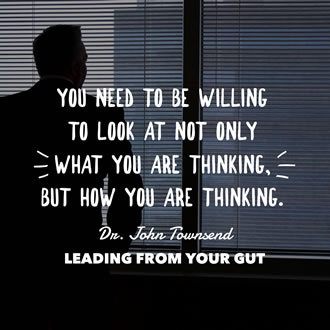 by Dr. John Townsend
by Dr. John Townsend
So how can you become a wise, sober-minded person of good judgment—one who thinks rather than reacts and routinely utilizes internal as well as external data? Start by becoming an observer of how you think. It may sound strange to think about thinking, but it is important and helpful. You can begin to pay attention to your thinking by routinely observing your thoughts and by recognizing any cognitive distortions.
Observe Your Thoughts—Without Trying to Control Them
Life is chaotic, and sometimes too much information can cause confusion in an organization. As a result, leaders are under great pressure to think with focus and direction. It is an important task. Sometimes, however, leaders interpret a need for clarity as a need to control their thoughts and keep them directed and precise. This is a problem. Leaders need to provide clarity to their organizations, but they need to also observe where their thoughts are leading and what they mean. There is much value that can come from observing your thoughts.
For example, think about someone in your organization who, when you are engaged in a conversation with him for more than a minute or two, your thoughts begin to wander. It can be like the movie scenes where a bored high-school student enters some daydream while his teacher drones on, then startles back to reality when she stands over him, saying, “Do you understand my question?” When talking to this person at work, you find yourself thinking about golf, lunch, or your date that night. As a result, you miss what the other person is saying and have to quickly catch up somehow so he won’t notice.
You may be tired. You may not be interested in the topic. But there are other reasons you may be thinking those particular imaginative thoughts. And if you understand those reasons, they can point to something valuable for you, the leader. For example:
He rambles on about details no one cares about, and he needs to be coached to be succinct.
He talks in an egocentric way about only his perceptions, and he needs to be helped to consider other people’s experiences and viewpoints.
You are annoyed with him about something, so you detach from him via your imagination. You may need to rectify that.
He is bringing you negative news you don’t want to hear. You may need to hear it anyway.
You can’t sufficiently detach from whatever you were doing and pay attention to him. You may need to refocus on him and return to the previous issue after the conversation.
Do you see all the potential these observations have to add value to your leadership? You can go beyond the symptom to the root cause and deal with it effectively. This is a far better use of your time and energy than not questioning your experience because, more often than not, the problem will only get worse over time.
The point is, you need to be willing to look at not only what you are thinking but how you are thinking. This process will pay off for you in the long term.
Recognize Cognitive Distortions
As part of observing your thoughts, you also need to be aware of ways your thoughts can be distorted or misleading. Psychologists refer to these biases as cognitive distortions, or patterns of thinking that aren’t reality-based and therefore hinder your productivity. There are several distortions that can hamper a leader’s thinking. As you read through the list below, see if you recognize any of these patterns in your own thinking and decision making.
Helplessness—the sense of “I’ve tried and nothing helps,” as if there are no choices available to you.
Passivity—a pattern in which you are afraid or hesitant to take initiative, so you wait for someone or some circumstance to provide the solution.
Negativity—a well-known pattern in leaders in which there is an imbalance of negative over positive. It is often justified as being “realistic,” but it is generally built on fear of failure, not reality.
Self-protective rationalizing—a scenario in which you are unable to own your own contribution to a problem or to see another person’s feedback as superior, so you rationalize your position to the point of uselessness.
One-solution thinking—the idea that there is only one answer to a situation. This kind of thinking is very limited and is usually produced by anxiety or a perfectionist streak. For example, “We need more clients in our medical center, so let’s advertise more.” Who knows, maybe it’s that plus community outreach plus better pricing plus warmer customer relationships. Sometimes there is only one answer, but most of the time there are several. The best thinking occurs when you look at various scenarios and play them out, either in your mind or with others.
False-self thinking—when you try to be someone you’re not by projecting an idealized or false version of yourself. You do this either to please people with that image or to keep yourself from seeing your own faults. It becomes a very restricted way of living and leading.
We all have some of these patterns to one degree or another. Identify the ones you might be challenged by. Then do a reality check with a couple of trusted and honest people who know you well. If the patterns exist, commit a thirty-day practice of reviewing the decisions you make each day. For each decision, look for any evidence of the cognitive distortion patterns you identified. Simply being aware of your patterns will go a long way in helping you to correct the problem. Once you are more aware, then ask a couple of well-grounded people, “How would you have thought about this issue?” Having others model healthy ways of thinking will help you to continue moving yourself in that direction.
________
Taken from Leading from Your Gut: How You Can Succeed by Harnessing the Power of Your Values, Feelings, and Intuition by Dr. John Townsend. Click here to learn more about this title.
 Get The 10 Laws of Boundaries eBook when you subscribe to the Boundaries Weekly email newsletter. Learn More
Get The 10 Laws of Boundaries eBook when you subscribe to the Boundaries Weekly email newsletter. Learn More
The post How to Think about Your Thinking appeared first on Boundaries Books.
April 7, 2020
You Can’t Always Get What You Want, but You’d Better Try
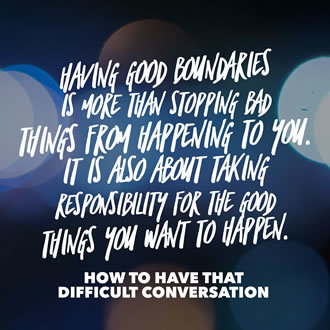 Telling other people what you want is key to feeling alive in a relationship and keeping things vibrant for both people. If only one person is getting his or her desires met, the relationship suffers. Unfortunately, many people do not get what they want in a relationship. But, they could if they knew how to communicate their desires.
Telling other people what you want is key to feeling alive in a relationship and keeping things vibrant for both people. If only one person is getting his or her desires met, the relationship suffers. Unfortunately, many people do not get what they want in a relationship. But, they could if they knew how to communicate their desires.
For example, Peter began dating Marla. At first, he was in absolute heaven. She was so “easy to get along with,” he said. About five months later, though, something happened. “I broke up with Marla,” he said. “It just wasn’t working out.”
”What happened?” I (Dr. Cloud) asked.
“In the beginning, she was like a breath of fresh air,” Peter replied. But as time went on, I noticed a couple of things. First, I could never figure out what she wanted. I would ask her what she wanted to do, or where she wanted to go, or how she felt about something, and she would always defer to me. Even though that felt good in the beginning, over time, I got bored with Marla’s flexibility. There was something missing. I don’t know exactly what it was.
Second, she wouldn’t really pout, but she would be sad, or quiet, or something. I would feel like I had done something wrong, but I didn’t know what it was. So I would ask. At first, she would say, ‘Nothing,’ but I knew that was bull. So I would have to pull it out of her, and then I would find out that she had wanted me to do something I hadn’t done, or that she was bugged about something she hadn’t told me about. I felt like I was letting her down, but I couldn’t read her mind. I was frustrated not knowing when things were okay and when they weren’t. I think I need someone more up front with what they are thinking and what they want.”
Many people think of “boundaries” only as setting limits, saying no, or trying to stop something destructive from happening. But having good boundaries is more than stopping bad things from happening to you. It is also taking responsibility for the good things you want to happen.
When you take responsibility for your desires and communicate them well, a relationship has much more chemistry, connection, and mutual fulfillment. You know about and negotiate any issues; there is give and take. And no one is walking around resentful and depressed.
Think about Peter and Marla for a moment. She had desires she wanted fulfilled in her relationship with Peter. But she thought Peter was responsible for knowing what her desires were and for taking the first step toward fulfilling them. She shifted the responsibility for what she wanted from her to him; she thought her “wants” were his problem, not hers. When he did not solve her problem, when she felt sad or resentful, she saw it as Peter’s responsibility to figure out what she was feeling and do something about it. Ultimately, this proved too much for him to do.
To have a relationship that works well, we should communicate our wants not outwardly, but inwardly. We should have a “responsibility” talk with ourselves before we have a “talk” with another person. Here are some of the things we will need to do:
Own our “want”—be honest about what we want and be aware that our desire is our responsibility.
Own the feelings that occur when our desire is not getting met—if we are sad, we needs to tell other people, not wait for them to figure it out.
Choose to communicate and move toward other people to let our wants be known.
Communicate desire, not demand.
We always have to look at ourselves first to make sure we are doing our part correctly. This is particularly true with wants and desires; others do not magically know what we want, and they need to be told in ways they can accept. So the first conversation has to take place inside.
Freedom is essential to a good relationship. If we’re not free, we can’t love. If people feel as though they can’t say “no” to us and if they do things for us out of compulsion, guilt, or feelings of obligation, they will resent doing those things. If we ask for things we want in ways that make someone feel as though “no” is not okay with us, the relationship turns into a control battle. Freedom and love suffer, and even fulfilled desires can’t fully satisfy because they are not given in love.
________
Adapted from How to Have That Difficult Conversation by Dr. Henry Cloud and Dr. John Townsend
 FREE! Get The 10 Laws of Boundaries eBook when you subscribe to the Boundaries Weekly email newsletter. Learn More
FREE! Get The 10 Laws of Boundaries eBook when you subscribe to the Boundaries Weekly email newsletter. Learn More
The post You Can’t Always Get What You Want, but You’d Better Try appeared first on Boundaries Books.
March 21, 2020
Four Boundaries Principles to Apply in Difficult Situations
 “I don’t know if this boundary stuff really works for me,” Jill told me (Dr. Townsend). She was having problems with her 14-year-old daughter. Holly was skipping classes at school and had been caught drinking. Things were definitely headed in the wrong direction, and Jill wanted to act before it was too late.
“I don’t know if this boundary stuff really works for me,” Jill told me (Dr. Townsend). She was having problems with her 14-year-old daughter. Holly was skipping classes at school and had been caught drinking. Things were definitely headed in the wrong direction, and Jill wanted to act before it was too late.
“What happened?” I asked.
“Well, I sat down and told her, ‘Things are going to have to change around here. I’m going to set some boundaries with you. This is for your own good. You need to stop the ditching and drinking.’”
“What happened then?”
“She got mad at me, yelled, and left the room. The next weekend she was drinking again. I guess the next step is to send her to some adolescent rehab center—”
“Slow down, Jill. That may be in the cards, but you’re ahead of yourself. I don’t think you’ve given Holly or yourself a real go in setting boundaries. Boundaries aren’t about just giving someone their marching orders and then expecting them to salute. Especially teens.”
Jill had thought that simply being direct and honest was all that was needed to set boundaries. But it isn’t. There are four necessary principles that must be used in order make boundaries succeed in difficult situations:
Principle #1 – Love: I Am on Your Side
Always begin with love. To the best of your ability, convey to your teen (or anyone else) that you care about her welfare and have her best interests at heart.
Boundaries separate people, at least at first. Because of this, setting boundaries often causes conflict. Teens get mad and feel persecuted. They resist boundaries, because boundaries seem harsh and uncaring.
Love will help your teen hear what you are saying, accept the boundaries, and tolerate the consequences. This is true for all of us. When we hear hard truths from someone who cares about us, we need to know that the person is on our side. Otherwise, we are liable to feel hated, bad, worthless, unloved, offended, or victimized. Those feelings don’t lead to a happy ending.
To demonstrate love to your teen, tell her something like this: “I am on your side. I am not doing this because I’m mad, or want to punish you, or don’t care about you. I am doing this because I want your best.” You may not be feeling especially close to your teen when you set a limit, but love is greater than momentary feelings. Love is a stance, an attitude to take: you are on your teen’s side and for her good.
Principle #2 – Truth: I Have Some Rules and Requirements
Love opens the door to change but is not enough. Truth provides guidance, wisdom, information, and correction. Truth exists in the form of rules, requirements, and expectations for your teen. They are the dos and don’ts that spell out what your teen needs to do and what he needs to avoid.
Why is this important? Because your teen needs to know what the line is, so that he can choose whether or not to cross it. If there is no line, you won’t be able to blame your teen for crossing it. Sometimes a boundary doesn’t work because the parent didn’t clearly define the boundary.
By the way, if you feel weird or mean about having rules and expectations for your teens, you should see that feeling as a problem! It is not cruel and unloving for parents to have requirements for their teen’s behavior and attitude. Teens who have reasonable expectations for their behavior tend to do better in life, because boundaries are part of life. Adults can’t show up for work late, nor should they yell at their spouse when they’ve had a bad day. As long as the rules are appropriate for the situation, when you bring them into the relationship, you are helping your child see that structure and responsibility are normal and expected in life.
Don’t get mad. Get clear. Let your adolescent know what is expected and required in behavior and attitude. Write down your rules and regulations and post them on the refrigerator. Otherwise, when he feels you are being unfair in your discipline, he may be right.
Principle #3 – Freedom: You Can Choose to Respect or Reject the Rules
Your teen has probably exercised freedom to make some poor choices, and you haven’t seen much good come from that. But freedom is absolutely necessary, for a couple of reasons:
First, you can’t really make your teen choose the right thing. It can be scary to realize this, but realize it you must. There is a lot you can’t control in your teen. You aren’t present for much of her life, so you can’t control what she does in school and with her friends. Nor can you really control what she does at home, if you think about it.
Second, even if you could “make” your teen do the right thing, it wouldn’t help him develop into a mature, loving, responsible person. That is not how God designed the growth process. He orchestrated things so that we must be free to choose good or bad, to choose him or reject him. That is the only way we can learn from our mistakes, and the only way we can truly love each other from the heart.
Of course, freedom has a limit. If a problem is life-threatening or dangerous, you certainly should intervene. Intervention in the form of involuntary hospitalizations, arrests, or residential treatment programs sometimes has to happen in extreme cases. You want your child alive to be able to grow. But as much as possible, affirm and protect your teen’s freedom.
Principle #4 – Consequences: Here Is What Will Happen
Teens need consequences, because that’s how they experience a fundamental law of life: good behavior brings good results and bad behavior brings uncomfortable results. Depending on the situation, your teen may need to experience something small, such as having to do extra chores at home. Or the consequence may need to be a big deal, such as grounding for a long time with few privileges. But the idea is the same: consequences teach us how to be responsible.
Consequences should be both said and done. Your teen needs to know what will happen on the other side of the line. If you state consequences without enforcing them, you will train your teen to ignore you, because your bark has no bite. The next time you decide you need to have a boundary-setting conversation, be sure you say:
Love – “I love you and am on your side.”
Truth – “I have some rules and requirements for your behavior.”
Freedom – “You can choose to respect or reject these rules.”
Consequences – “Here is what will happen if you reject these rules.”
When you use these four principles, you are providing the stability, clarity, and motivation your teen needs to begin to learn self-control and responsibility.
________
Boundaries with Teens can help you establish wise and loving limits that make a positive difference in your adolescent, in the rest of your family, and in you. Click here to learn more about this book.
 Get The 10 Laws of Boundaries eBook when you subscribe to the Boundaries Weekly email newsletter. Learn More
Get The 10 Laws of Boundaries eBook when you subscribe to the Boundaries Weekly email newsletter. Learn More
The post Four Boundaries Principles to Apply in Difficult Situations appeared first on Boundaries Books.
March 12, 2020
Three Steps to Enjoying the Rewards of Boundaries
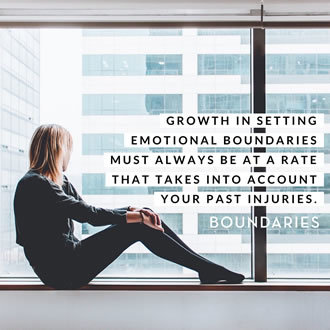 Jean used to believe that she would never learn how to say no and make it stick. But, as she sat at her kitchen table with a teacup in hand, she felt amazed. It was an unfamiliar sensation, but a pleasant one.
Jean used to believe that she would never learn how to say no and make it stick. But, as she sat at her kitchen table with a teacup in hand, she felt amazed. It was an unfamiliar sensation, but a pleasant one.
Her mind wandered back to the events of the morning. Her eight-year-old son, Bryan, had begun the day with his usual waking-up shenanigans. He sulked and pouted his way to the breakfast table, announcing, “I’m not going to school — and no one’s going to make me!”
Normally Jean would have either tried to talk Bryan into attending school, or blown up at him in frustration. However, this morning was different. Jean simply said, “You’re right, Honey. No one can make you go to school. That has to be something you choose to do. However, if you don’t choose to go to school, you are choosing to stay in your room all day with no TV. But that’s something you’ll have to decide for yourself, like you did last week.”
Bryan hesitated in his tantrum. He was thinking about when Mom had made him stay in his room and miss dinner when he had refused to set the table. Finally, he said, “Well, I’ll go — but I don’t have to like it!”
“Absolutely,” Jean agreed. “You don’t have to like a lot of things like school. But I’m sure you’ve made the right choice.” She helped Bryan on with his jacket and watched him walk to the carpool ride outside.
Not ten minutes later, Jean had received a call from her husband, Jerry, who had driven to work early. “Honey,” he said. “I just found out I have a meeting after work. The last time I showed up late for dinner, there wasn’t any. Think you could save some this time?” Jean laughed. “Last time, you never called me to let me know. I really appreciate your telling me in advance. I’ll feed the kids, and you and I’ll eat together later.”
Jean thought to herself, “My son makes it to school, even with a cranky attitude. My husband calls me to inform me about schedule changes. I’m dreaming, aren’t I, Lord?”
Jean wasn’t dreaming. She was, for the first time in her life, experiencing the rewards of setting and maintaining clear boundaries in her life. A great deal of hard work and risk-taking had gone into them. Jean saw visible, demonstrable proof that her boundary work was bearing fruit in her life. Things were different. But how did she get from Point A (boundarylessness) to Point B (mature boundaries)? Can we measure our boundary development?
Step 1: Practice Baby No’s
Growth in setting emotional boundaries must always be at a rate that takes into account your past injuries. Otherwise, you could fail massively before you have solid enough boundaries.
“This boundary teaching doesn’t work,” complained Frank in a therapy session.
“Why not?” I asked.
“Well, as soon as I understood that I don’t set good limits with people, I called my father the same day and gave him what for. Can you believe what he did? He hung up on me! This is great, just great. Boundaries have made things worse for me, instead of better.”
Frank is like the overeager child who is too impatient for training wheels on his new bicycle. It’s only several falls and skinned knees later that he begins to entertain the possibility that he skipped some steps in his training.
Here’s an idea to help you navigate this step. Ask your support group or your good friends if you could work on boundaries with them. They will show you their true value in their response to your truth-telling. Either they’ll warmly cheer you on in being able to disagree with and confront them, or they’ll resist you. Either way, you’ll learn something.
A good supportive relationship cherishes the no of all parties involved. The members know that true intimacy is only built around the freedom to disagree: “He who conceals his hatred has lying lips” (Proverbs 10:18). Begin practicing your no with people who will honor it and love you for it.
Step 2: Rejoice in the Guilty Feelings
As strange as it may seem, a sign that you’re becoming a boundaried person is often a sense of self-condemnation, a sense that you’ve transgressed some important rules in your limit setting. Many people experience intense critical self-judgment when they begin telling the truth about what is and isn’t their biblical responsibility. Why is that? Let’s look at the answer in terms of slavery and freedom.
Boundary-injured individuals are slaves. They struggle to make value-based decisions on their own, but they most often reflect the wishes of those around them. And even though they can be surrounded by supportive boundary lovers, they still experience trouble setting limits.
The culprit here is a weak conscience, or an overactive and unbiblically harsh internal judge. Though we need our internal “evaluator” to help us know right from wrong, many people carry around an extremely self-critical — and inaccurate — conscience. They feel that they are transgressing when they aren’t.
Because of this overactive judge, the boundary-injured individual often has great difficulty setting limits. Questions such as, “Aren’t you being too harsh?” and “How can you not attend the party? What a selfish thought!” are raised.
You can imagine the havoc when the struggler actually sets a limit or two, even a small one. The conscience moves into overdrive, as its unrealistic demands are being disobeyed. This rebellion against honest boundaries is a threat to the parental control of the conscience. It attacks the soul with vigor, hoping to beat the person into submitting again to its untruthful do’s and don’ts.
In a funny way, then, activating the hostile conscience is a sign of spiritual growth. A signal that you may be protesting unbiblical restraints. If the conscience were silent and providing no “how could you?” guilt-inducing messages, it might mean that you were remaining enslaved to the internal parent. That’s why we encourage you to rejoice in the guilt. It means you are moving ahead.
Step 3: Practice Grown-Up No’s
Think for a minute about this question: Who is your number-one “boundary buster”? Who is the foremost person in your life with whom it’s difficult to set limits? More than one person may come to mind. This step deals with those extremely complicated, conflictual, frightening relationships. Straightening out these relationships is a major goal in becoming a boundaried person.
This step underscores the importance of making sure we’ve done our painstaking homework and practice before now. Setting important limits with significant people is the fruit of much work and maturing.
It’s important not to confuse our goals here. Often, Christians who have been boundary injured think that the objective is to set limits on those important areas, and get life stabilized again. They may be living for the day when “I can tell Mom no.” Or when “I can set limits on my husband’s drinking.” While these sorts of confrontations are very important, they aren’t the ultimate target of learning boundaries.
Our real target is maturity — the ability to love successfully and work successfully, the way God does. Boundary setting is a large part of maturing. We can’t really love until we have boundaries. Otherwise, we love out of compliance or guilt. And we can’t really be productive at work without boundaries, or we’re so busy following others’ agendas that we’re double-minded and unstable. The goal is to have a character structure that has boundaries and that can set limits on self and others at the appropriate times.
________
Learn more about how to say no and really mean it by reading The New York Times bestselling book, Boundaries.
 Get The 10 Laws of Boundaries eBook when you subscribe to the Boundaries Weekly email newsletter. Learn More
Get The 10 Laws of Boundaries eBook when you subscribe to the Boundaries Weekly email newsletter. Learn More
The post Three Steps to Enjoying the Rewards of Boundaries appeared first on Boundaries Books.
March 2, 2020
What Should I Do with a Teenager Who Refuses to Change?
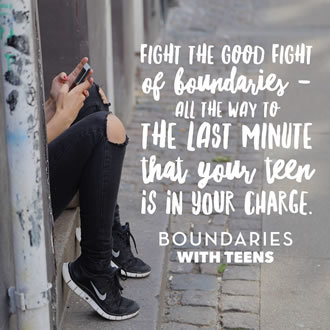 I (Dr. John Townsend) have talked to many young adults who have told me, “When I was a teenager, I acted like my parents had nothing to say to me. I couldn’t afford to act differently. But inside, it mattered a lot what they said.”
I (Dr. John Townsend) have talked to many young adults who have told me, “When I was a teenager, I acted like my parents had nothing to say to me. I couldn’t afford to act differently. But inside, it mattered a lot what they said.”
You can’t predict how telling the truth and establishing healthy boundaries will affect a teen, nor can you predict when the change will occur. I have seen parents with a seventeen-year-old who would be moving out in a few weeks still make significant inroads with a rebellious and destructive attitude. Don’t let your fears and discouragement limit a process of growth that God designed for your child. Sometimes the right intervention, given at the right time, with the right people, can make all the difference in the world.
Even so, Let’s suppose you do have a teen who is not doing well and is almost out of the house. Consider the alternative. If you give up and go into survival mode, your teen has not experienced the benefit of being around loving, truthful, and strict parents and will be that much less ready for successful adulthood. Even if your teen resisted every effort you attempted and you saw no change at all, something good has still happened. In those last months and weeks, she has experienced and internalized some events that cannot be easily shaken loose. For that brief time, love, responsibility, freedom, and consequences were applied to your teen’s life in a way that was healthy and good.
As a psychologist, I have met many adults who blew off their parents’ help when they were teenagers, only to remember years later what had been done. And they know at some level that that was a good way for them to live. So even if you don’t see the fruit today or tomorrow, your teen will still have some memories of the way life should be lived. Take encouragement from the words of the prodigal son in the Bible who finally “got it”:
“When he came to his senses, he said, ‘How many of my father’s hired men have food to spare, and here I am starving to death! I will set out and go back to my father and say to him: Father, I have sinned against heaven and against you. I am no longer worthy to be called your son; make me like one of your hired men.’” (Luke 15:17-19)
Don’t count on getting an apology like that. Instead, fight the good fight of setting boundaries — all the way to the last minute that your teen is in your charge. Your investment of time and energy will not be in vain.
________
Boundaries with Teens can help you establish wise and loving limits that make a positive difference in your adolescent, in the rest of your family, and in you. Learn More
 Get The 10 Laws of Boundaries eBook when you subscribe to the Boundaries Weekly email newsletter. Learn More
Get The 10 Laws of Boundaries eBook when you subscribe to the Boundaries Weekly email newsletter. Learn More
The post What Should I Do with a Teenager Who Refuses to Change? appeared first on Boundaries Books.
February 28, 2020
How to Cure Your Fear of Being Alone
 “Just call him and tell him that it is over,” I (Dr. Cloud) said to Marsha. I had listened to her for months now about her dating relationship with Scott and how she could not stand some of his hurtful patterns. And I was getting both concerned and tired of her denial of the kind of person that he really was. I began to push her.
So she decided to do it. She called him and broke it off. As expected, he went crazy and showed up at her door begging for her to not go through with it. There were all sorts of promises of change and the usual things that people in denial say when threatened with loss of love. But she held her ground. At least for a day.
“Just call him and tell him that it is over,” I (Dr. Cloud) said to Marsha. I had listened to her for months now about her dating relationship with Scott and how she could not stand some of his hurtful patterns. And I was getting both concerned and tired of her denial of the kind of person that he really was. I began to push her.
So she decided to do it. She called him and broke it off. As expected, he went crazy and showed up at her door begging for her to not go through with it. There were all sorts of promises of change and the usual things that people in denial say when threatened with loss of love. But she held her ground. At least for a day.
Two days later, Marsha called and canceled her next appointment. I called her back and found out the truth. She had gone back to Scott and was ashamed to tell me. I told her to come in anyway so we could talk about it.
As Marsha talked, I felt for her. She described the depression and aloneness that she went into when she broke it off and held her ground. She felt as if she were in a black hole that she could not see out of, and she felt completely hopeless. It was really a dangerous state.
No one who knew Marsha would have suspected her inner agony. She was a strong person in the business world, a committed Christian, and a ministry leader in her church. Everyone loved her, and no one would have thought that she would put up with someone like Scott, or that she could be so devastated by breaking up with such a jerk. But the breakup had left her so sad that she could barely function.
As we worked on Marsha’s feelings, we found that there was a very deep part of her that felt very much alone and unloved, and breaking up with Scott was bringing out a deep aloneness that normally she did not experience. And, as we began to look at her history, she avoided experiencing this internal aloneness by dating men. Each time she would end one relationship, there would be another one, even though they would not be men that she would want to be with long-term. She just could not stand to be alone. And so, her fear of being alone kept her from having boundaries with bad relationships. She would rather give in to a bad relationship than have no relationship at all.
This is a key point about boundaries in dating. If you do any of the following, then you might be giving up boundaries because of a fear of being alone:
Putting up with behavior that is disrespectful
Giving in to things that are not in accord with your values
Settling for less than you know you really desire or need
Staying in a relationship that you know has passed its deadline
Going back into a relationship that you know should be over
Getting into a relationship that you know is not going anywhere
Smothering the person you are dating with excessive needs or control
And surely there are other signs as well. But the point is, your aloneness makes you get involved in relationships that you know are not going to last. It also keeps you from being alone long enough to grow into a person who does not have to be in a relationship in order to be happy. There is a very important rule in dating and romance: To be happy in a relationship, and to pick the kind of relationship that is going to be the kind you desire, you must be able to be happy without one.
If you must be dating or married in order to be happy, you are dependent, and you will never be happy with whatever person you find. The dependency will keep you from being selective enough to find the kind of person who will be good for you, or will keep you from being able to fully realize a relationship with a healthy person. If you are afraid of aloneness and abandonment, you cannot use the love of people who are truly there until you deal with your own fears.
So, aloneness must be cured first, and this is a good boundary for dating. Here is the boundary: In order to cure your fear of being alone, you need to put a boundary around your wish for a relationship. Cure that fear first, and then find a relationship. How do you cure your aloneness without a dating relationship?
First, strengthen your relationship with God. Make him your first priority so that you are not trying to get God needs met by a relationship with a person.
Second, strengthen your relationships with safe, healthy Christians. Make sure that you are not trying to get your people needs met by a dating relationship, or by God. Yes, you need God. But you also need people.
The best boundary against giving in to bad relationships, less-than-satisfactory relationships, or bad dynamics in a good relationship is your not needing that relationship. And that is going to come from being grounded in God, grounded in a support system, working out your issues, having a full life, and pursuing wholeness. If you are doing those things, you will not be subject to saying yes when you should be saying no.
________
For more great advice to help you avoid bad dating situations and build a great relationship, read Boundaries in Dating. Click here to learn more.
 Get The 10 Laws of Boundaries eBook when you subscribe to the Boundaries Weekly email newsletter. Learn More
Get The 10 Laws of Boundaries eBook when you subscribe to the Boundaries Weekly email newsletter. Learn More
The post How to Cure Your Fear of Being Alone appeared first on Boundaries Books.



